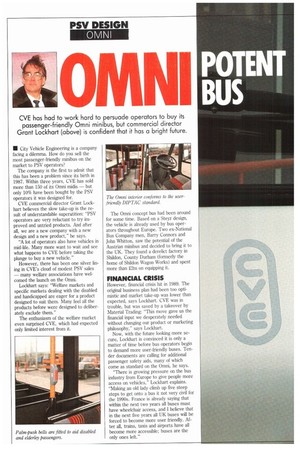POTENT BUS
Page 52

Page 54

If you've noticed an error in this article please click here to report it so we can fix it.
City Vehicle Engineering is a company facing a dilemma. How do you sell the most passenger-friendly minibus on the market to PSV operators?
The company is the first to admit that this has been a problem since its birth in 1987. Within three years, CVE has sold more than 150 of its Omni midis — but only 10% have been bought by the PSV operators it was designed for.
CVE commercial director Grant Lockhart believes the slow take-up is the result of understandable superstition: "PSV operators are very reluctant to try improved and untried products. And after all, we are a new company with a new design and a new product," he says.
"A lot of operators also have vehicles in mid-life. Many more want to wait and see what happens to CVE before taking the plunge to buy a new vehicle."
However, there has been one silver lining in CVE's cloud of modest PSV sales — many welfare associations have welcomed the bunch on the Omni.
Lockhart says: "Welfare markets and specific markets dealing with the disabled and handicapped are eager for a product designed to suit them. Many feel all the products before were designed to deliberately exclude them."
The enthusiasm of the welfare market even surprised CVE, which had expected only limited interest from it.
The Omni concept bus had been around for some time. Based on a Steyr design, the vehicle is already used by bus operators throughout Europe. Two ex-National Bus Company men, Barry Connors and John Whitton, saw the potential of the Austrian minibus and decided to bring it to the UK. They found a derelict factory in Shildon, County Durham (formerly the home of Shildon Wagon Works) and spent more than £2m on equipping it.
However, financial crisis hit in 1989. The original business plan had been too optimistic and market take-up was lower than expected, says Lockhart. CVE was in trouble, but was saved by a takeover by Material Trading: "This move gave us the financial input we desperately needed without changing our product or marketing philosophy," says Lockhart.
Now, with the future looking more secure, Lockhart is convinced it is only a matter of time before bus operators begin to demand more user-friendly buses. Tender documents are calling for additional passenger safety aids, many of which come as standard on the Omni, he says.
"There is growing pressure on the bus industry from Europe to give people more access on vehicles," Lockhart explains. "Making an old lady climb up five steep steps to get onto a bus it not very civil for the 1990s, France is already saying that within the next two years all buses must have wheelchair access, and I believe that in the next five years all UK buses will be forced to become more user friendly. After all, trains, taxis and airports have all become more accessible; buses are the only ones left."
Lockhart reckons that the Ornni is the bus that "puts people first". It was designed with help from the Transport and Road Research Laboratory, the Motor Industry Research Association and the Cranfield Institute of Technology, and is one of few minibuses to be designed with the Disabled Person Transport Advisory Committee recommendations in mind. These include colour-contrasting handrails, palm operated bell-pushes, wide entrances and non-slip flooring.
"DIPTAC recommendations are not just for the disabled but also for the old as they get less strong, or even young mothers with children," says Lockhart. "The Omni is built with the passengers in mind. Buses are usually built just for bus companies and for their chief engineers."
CVE is particularly proud of the Omni's low (315mm) single entrance and flat floor — made possible by front-wheel drive. "Our ultimate objective is to get the entrance step below the kerb so people can step into the bus," says Lockhart.
The Omni is also the only minibus to meet European Community rollover standards which, so far, apply only to coaches. "We were aware that there have been a lot of accidents with minibuses," says Lockhart. "Most minibuses are converted vans which are really designed to carry goods. When a van turns over it tends to collapse."
The Omni features a turbocharged Land Rover engine (a turbocharged three-litre Perkins engine is available as an option). Power steering comes as standard, and the bodywork comprises easily repairable, corrosion-proof GRP panels. For welfare use CVE offers rear air-suspension which allows the bus to be lowered at the back to just a few centimetres off the ground.
This kneeling system now seems likely to be incorporated in CVE's plans to produce a 33-seater version, if the firm decides it is a viable proposal. The main selling point is its low entrance to suit the bigger wheels on a midibus.
The company also plans to export the Omni, and countries including Japan are showing considerable interest.
Work is underway for a mobile workshop based on the Omni design, along with ambulance derivatives, which would feature all the passenger-friendly add-ons of the minibus.
"People travelling in an ambulance usually have something wrong with them, so why toss them about like a packet of cornflakes?" Lockhart asks.
Iii by Tanya Cordrey








































































































































